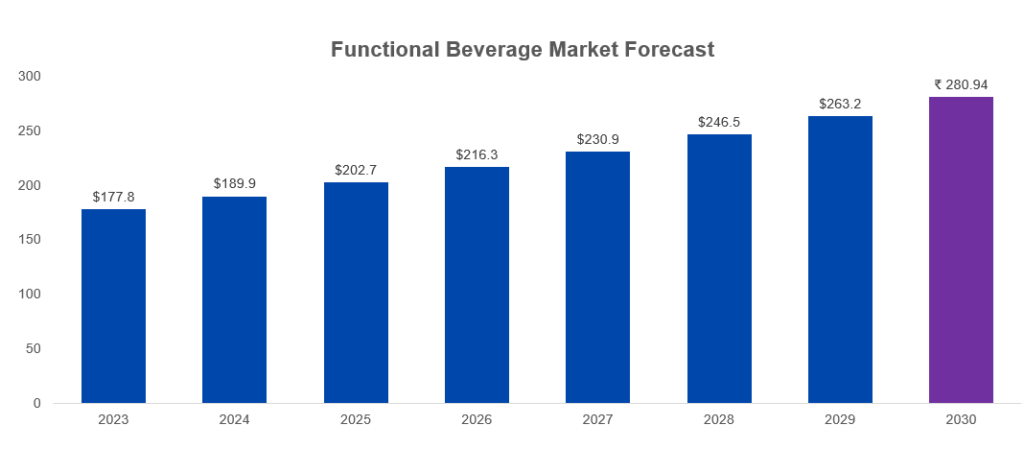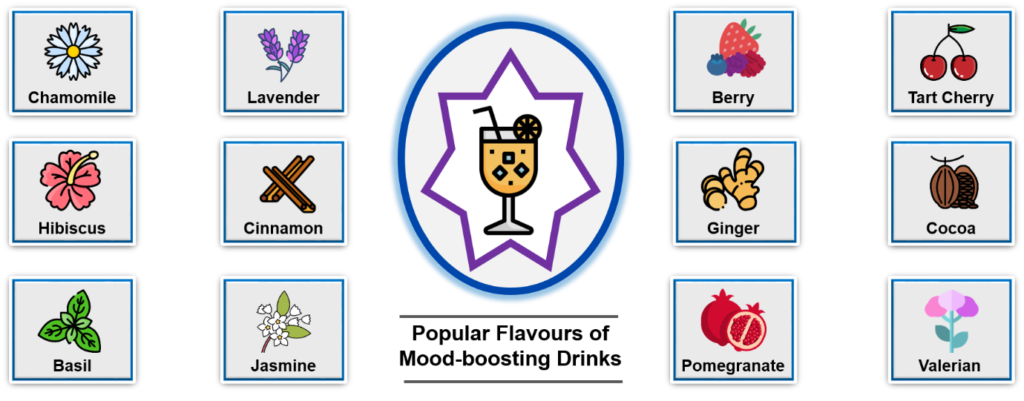Mood balancing is the latest chapter in the market of health drinks that is witnessing an upsurge with advancements in technology. The alarming health cases post-pandemic, especially the mental health issues, triggered the need for supplements or food & drinks that can uplift the mood of consumers. The cases of anxiety and depression spiked by almost 25 percent, as per a report by the World Health Organization (WHO). So, to crawl out of the trauma, people have started trying recipes, foods, mood-enhancing or relaxation drinks, or relaxation beverages that can elevate their happy hormones (endorphins, dopamine, and oxytocin).
Why are Mood Enhancing Drinks Finding Acceptance?
The demand for supplements to adjust the mood or influence it by some drink or food is not new. Earlier, people found solace in alcoholic beverages. However, with time and scientific renaissance, consumers are looking for healthier options to uplift their mood. Thus, the upsurge in the market.
Also, given the anxiety disorders, high-stress levels, and preference for healthy drinks, the market size is believed to grow exponentially. Notably, the United States has 40 million (19.1 percent) adults suffering from anxiety. Meanwhile, 7 percent of children aged 3 to 17 years also suffer from it in the US. So, the escape mode for it is the right food and drinking habits.
Moreover, it has been noticed that the global economy is losing USD 1 trillion each year following mental issues in the staff. Moreover, the cost of mental health conditions (and related ailments is slated to increase to $6 trillion globally by 2030. Thus, the loss of productivity at work will greatly impact businesses. Prior studies from the US estimated the economic burden of diagnosed depression to be 1.6% of its Gross Domestic Product (GDP).
How are Mood-boosting Drinks Different From Regular Drinks?
Mood-boosting or enhancing drinks precisely aims to reduce or diminish the effect of anxiety and stress on consumers while improving their mood. Moreover, the formulation of mood drinks is such that it elevates the emotional state of an individual. However, other beverages do not have the ingredients that are supposed to offer relaxation or cast away mental fatigue. Non-alcoholic drinks like cola (soft drinks) or soda are fun drinks sans good effects on the body. Likewise, the chemical combination of alcohol is such that it does not help a person with stress.
Global Market of Functional Drinks
Mood drinks are in the nascent stage of growth but have already become a crucial part of the functional drinks market that is finding ways like energy drinks. As per Stellarix’s research, the functional drinks market will grow at CAGR 6.75. The market will grow from 177.8 billion in 2023 to 280.94 billion in 2030, with mood drinks being a major contributor, given the added awareness and exponential demand.

Figure 1: Growth of the functional beverage market globally in billion dollars
Mood Drinks Pack Nutrients
- Increasing health consciousness: Consumers’ awareness of better health consciously pushes them to opt for well-being through drinks. So, the spike in sales for mood drinks is due to that.
- Premiumization trend: Consumers are willing to pay extra for quality. They want handcrafted drinks or beverages tailored to their moods. Hence, the premiumization trend is hovering around the non-alcoholic market.
- Mood support: With the demand to improve mental health, consumers have become more interested in regulating their mood and mental health. The market is rising rapidly year-on-year.
- Plant-based and natural ingredients: The need to drink plant-based nutrients or natural ingredients in beverages is increasing among consumers. The reason is that sustainable drinks alter the mood through different tastes and flavors.
- Direct-to-consumer channels: With mood drinks available through online clicks on e-commerce websites, direct-to-consumer channels have facilitated easier access to a wide range of niche brands. Thus, broader, bigger, and more targeted reach has become swift to audiences.
- Innovative functional beverages: The space for experimentation and innovation in functional beverages is the key driving mood drink consumption and the industry. Consumers get the choice to try drinks more than quenching their thirst for water or hydration purposes.
- Celebrity endorsements: Product promotions and celebrity endorsements can significantly impact the sales of functional beverages, further contributing to the market’s growth
- Online sales: The increasing popularity of online sales channels has contributed to the growth of the non-alcoholic drinks market, with online sales projected to contribute 3.8% of the total revenue in 2023
- Out-of-home consumption: Out-of-home consumption, including establishments like bars and restaurants, is expected to account for 40% of spending and 10% of volume consumption in the non-alcoholic drinks market
Benefits of Mood-boosting Drinks Ingredients
- Caffeine: Can provide a boost in alertness and mood
- L-theanine: It’s an amino acid in tea that promotes relaxation and calmness
- Ginger extract: This has been used for the potential of mood-boosting effects
- Green tea: Contains L-theanine, which promotes relaxation and a focused calm
- Turmeric: It’s known for its anti-inflammatory qualities
- Ashwagandha, cordyceps, and lion’s mane: These adaptogenic ingredients provide strength to the body and relieve stress and anxiety
- Jasmine tea: It’s a powerful anti-oxidant known for boosting immunity and fighting harmful bacteria. It keeps the mood lighter through its taste and fragrance
- Tart cherry juice: Can help improve sleep, which in turn can positively shift mood
- Normal Tea: Contains comforting spices like cinnamon, which can lead to increased feelings of alertness and help stabilize blood sugar levels

These flavors are often associated with relaxation, energy, and mood enhancement, and they are commonly found in various mood-boosting beverages.
Brands Offering Mood-Boosting Drinks
As the demand for wellness drinks increases, several companies are bottling drinks with mood-calming effects and essential vitamins and minerals.
Kin Euphorics: The well-packaged line of non-alcoholic beverage makers claims to be a functional drink rooted in Ayurveda. As mentioned on the website, it carries the entourage of herbs and natural ingredients that nourish the body and mind. The brand provides cans and bundles that pack Botanics, adaptogen, and nootropics. Interestingly, supermodel Bella Hadid is the co-founder of the company.
Trip:- The brand focuses on calming the brain through various ingredients, including CBD. The mood drink claims to inherit chamomile, turmeric, and ginseng. It also packs adaptogens to counter stress. Its top flavors that are in demand include elderflower-mint, lemon-basil, and peach-ginger.
Recess: The mood booster drink comes in multiple flavors to entice customers. The brand aims to relax and unwind its buyers’ brains. It offers multiple samples, viz., the zero-proof sampler, the new mood sampler, the recess sampler, and the 15ct stick pack sampler. The company is storming the mark with its watermelon mojito, lime margarita, ginger lime mule, and grapefruit paloma.
Moment: For moments of bliss, to uplift spirits, and enhance focus, the brand Moment flourished in the market with drinks that contain mood-enhancing ingredients along with natural adaptogens. The brand works on elevating mood with a positive mindset and clarity. Their top products include blueberry ginger, blood orange ashwagandha, cherry chaga, lychee mint, and lemon turmeric.
Conclusion
Given the facts and figures, the mood drinks market seems ripe for disruption and grabbing. It is as open as sports energy drinks. From 2015 to 2019, nootropic product launches grew by an average of 70% on a year-over-year basis globally. With consumer demand driving growth in this market, a little understanding of natural ingredients, trending formulations, and market shifts could be the key to gaining an edge in the mood drinks niche.
Also, consumers looking for non-alcoholic drinks and healthy options are quickly disassociating with artificial sweetener drinks and bland and flavored waters. The breakthrough is nourishing the customer base, which is growing rapidly and making inroads for investors and industries. Catering to the wellness movement can be piqued as another revolution. The United States is the testament where the relaxation drink production is witnessing sustained revenue growth. Also, global manufacturers and sellers are finding takers for mood-boosting drinks as they are healthy and restore the traditional tastes inherited by ancestors.